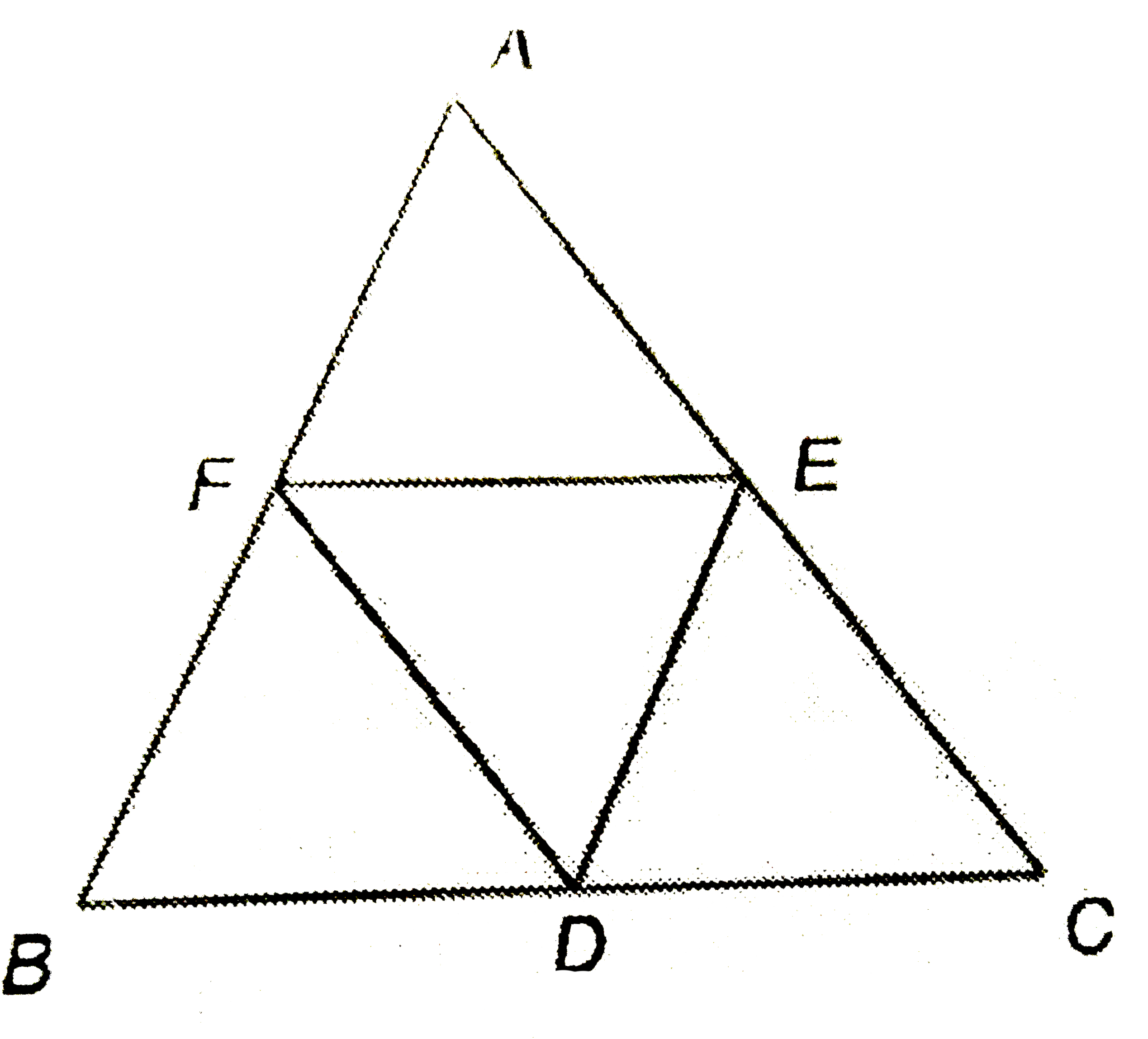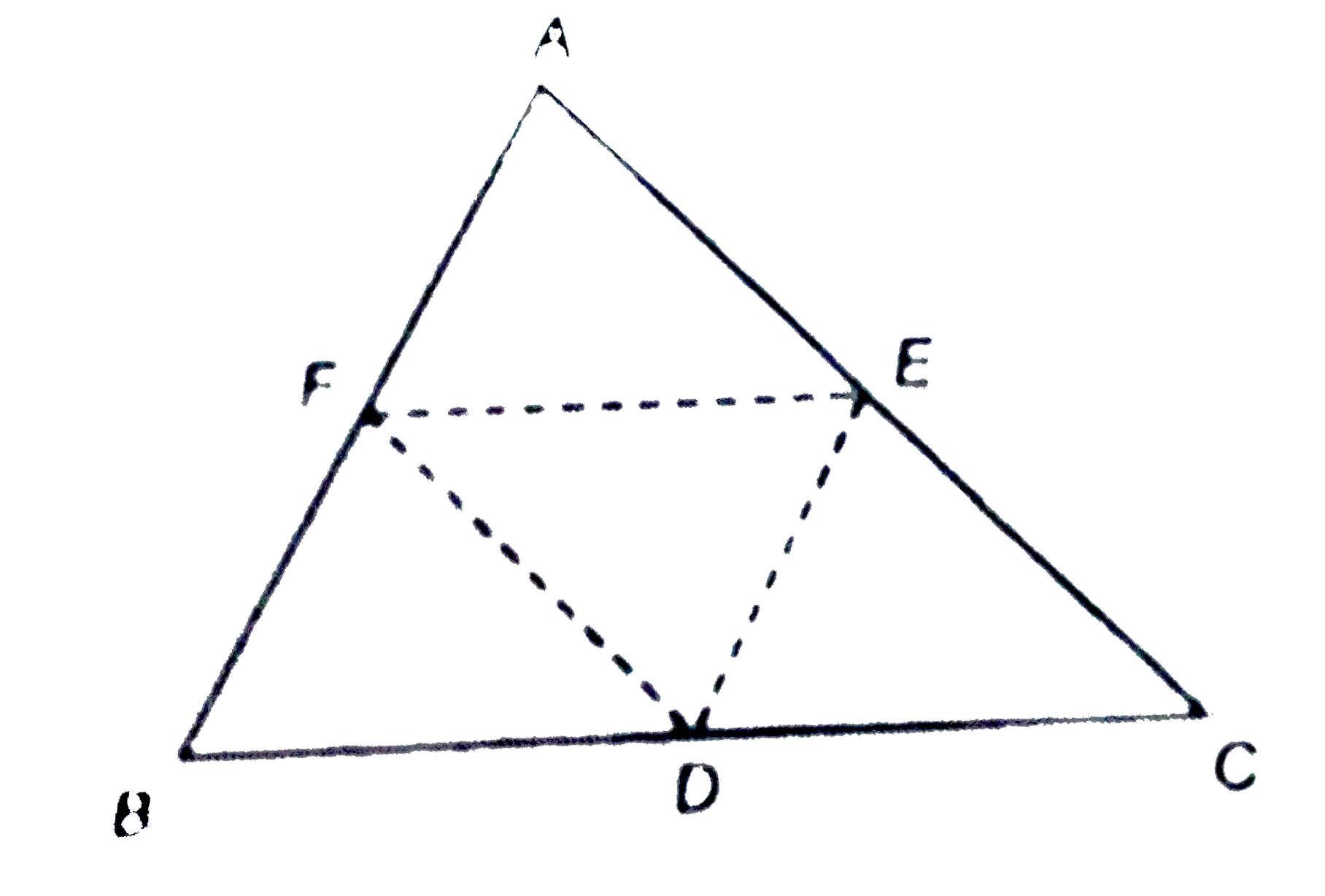D, E and F are the mid-points of the sides AB, BC and CA of an isosceles triangle ABC in which AB = BC. Prove that is also isosceles.
The correct Answer is:
To prove that triangle DEF is isosceles, we will use the properties of midpoints and the Midpoint Theorem. Let's go through the steps systematically.
1. Identify the Triangle and Midpoints:
- Let triangle ABC be an isosceles triangle where AB = BC.
- Let D, E, and F be the midpoints of sides AB, BC, and CA respectively.
2. Apply the Midpoint Theorem:
- According to the Midpoint Theorem, the line segment joining the midpoints of two sides of a triangle is parallel to the third side and half its length.
- Therefore, since D and E are midpoints of AB and BC:
DE=12AC
3. Find Lengths of Other Sides:
- Similarly, since E and F are midpoints of BC and CA:
EF=12AB
- And since F and D are midpoints of CA and AB:
FD=12BC
4. Use the Given Information:
- Since AB = BC (as given in the problem), we can substitute:
EF=12AB=12BC
5. Establish Equality of Two Sides:
- Now we have:
DE=12ACandEF=12AB
- Since AB = BC, we also have:
EF=12BC
- Thus, we can conclude:
DE=EF
6. Conclusion:
- Since DE = EF, triangle DEF is isosceles with DE = EF.
Final Statement:
Therefore, we have proved that triangle DEF is isosceles.
---
- Let triangle ABC be an isosceles triangle where AB = BC.
- Let D, E, and F be the midpoints of sides AB, BC, and CA respectively.
- According to the Midpoint Theorem, the line segment joining the midpoints of two sides of a triangle is parallel to the third side and half its length.
- Therefore, since D and E are midpoints of AB and BC:
DE=12AC
- Similarly, since E and F are midpoints of BC and CA:
EF=12AB
- And since F and D are midpoints of CA and AB:
FD=12BC
- Since AB = BC (as given in the problem), we can substitute:
EF=12AB=12BC
- Now we have:
DE=12ACandEF=12AB
- Since AB = BC, we also have:
EF=12BC
- Thus, we can conclude:
DE=EF
- Since DE = EF, triangle DEF is isosceles with DE = EF.
Therefore, we have proved that triangle DEF is isosceles.
Topper's Solved these Questions
- MID-POINT THEOREMBook:ICSEChapter:MID-POINT THEOREMExercise:4 MARKS QUESTION
Explore 15 Videos
- MID-POINT AND ITS CONVERSE(INCLUDING INTERCEPT THEOREM)Book:ICSEChapter:MID-POINT AND ITS CONVERSE(INCLUDING INTERCEPT THEOREM)Exercise:EXERCISE 12(B)
Explore 23 Videos
- PYTHAGORAS THEORAMBook:ICSEChapter:PYTHAGORAS THEORAMExercise:QUESTIONS
Explore 9 Videos
Similar Questions
In the adjoining figure D, E and F are the mid-points of the sides BC, CA and AB of the equilateral ΔABC. Prove that ΔDEF is also an equilateral triangle.

View SolutionD, E and F are the mid-points of the sides BC, CA and AB respectively of triangle ABC. Prove that:
BDEF is a parallelogram.
View SolutionD, E and F are the mid-points of the sides BC, CA and AB respectively of triangle ABC. Prove that:
area of BDEF is half the area of ΔABC.
View SolutionD, E and F are the mid-points of the sides BC, CA and AB, respectively of an equilateral ΔABC. Show that ΔDEF is also an equilateral triangle.
View SolutionIf D, E and F be the middle points of the sides BC,CA and AB of the ΔABC, then AD+BE+CF is
View SolutionD and F are the mid-points of sides AB and AC of a triangle ABC. A line through F and parallel to AB meets BC at point E.
Prove that BDFE is a parallelogram
View SolutionIn the adjoining figure D, E and F are the mid-points of the sides BC, CA and AB respectively of ΔABC. Prove that:
(i) □BDEF is a parallelogram
(ii) area of ΔDEF=14× area of ΔABC
(iii) □BDEF=12× area of ΔABC

View SolutionD, E and F are respectively the mid-points of sides AB. BC and CA of △ABC. Find the ratio of the areas of △DEF and △ABC.
View SolutionD and F are the mid-points of sides AB and AC of a triangle ABC. A line through F and parallel to AB meets BC at point E.
Find AB, if EF=4.8cm.
View SolutionD, E and F are the mid-points of the sides AB, BC and CA respectively of A ABC. AE meets DF at O. P and Q are the mid-points of OB and OC respectively. Prove that DPOF is a parallelogram.
View Solution